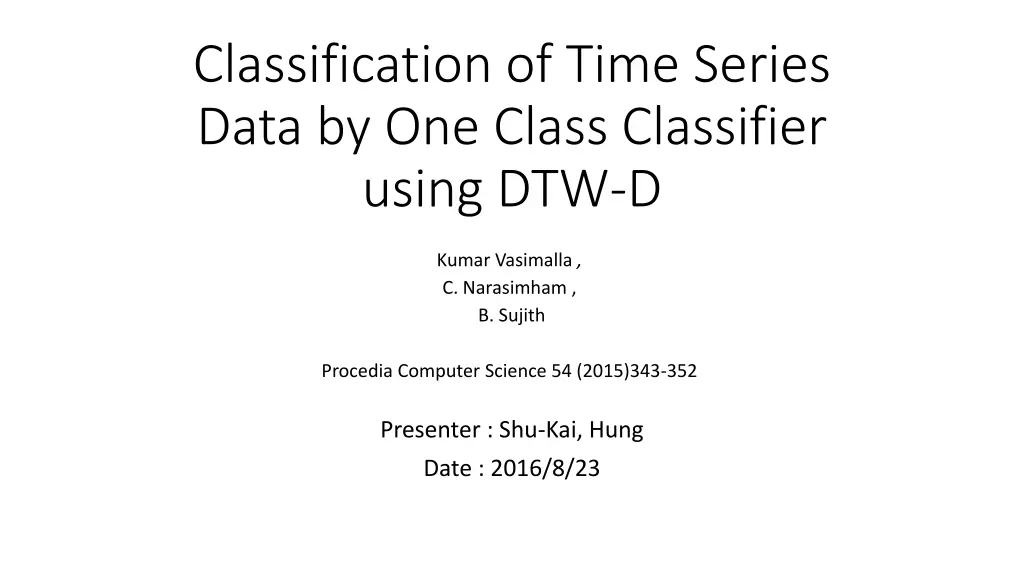
Classification of Time Series Data with DTW-D: A Special Distance Measure
Dive into the world of time series data classification using a one-class classifier and DTW-D, a unique distance measure. Explore the challenges, solutions, and benefits of this approach in various real-world applications.
Download Presentation

Please find below an Image/Link to download the presentation.
The content on the website is provided AS IS for your information and personal use only. It may not be sold, licensed, or shared on other websites without obtaining consent from the author. If you encounter any issues during the download, it is possible that the publisher has removed the file from their server.
You are allowed to download the files provided on this website for personal or commercial use, subject to the condition that they are used lawfully. All files are the property of their respective owners.
The content on the website is provided AS IS for your information and personal use only. It may not be sold, licensed, or shared on other websites without obtaining consent from the author.
E N D
Presentation Transcript
Classification of Time Series Data by One Class Classifier using DTW-D Kumar Vasimalla , C. Narasimham , B. Sujith Procedia Computer Science 54 (2015)343-352 Presenter : Shu-Kai, Hung Date : 2016/8/23
Abstract Time series data classification is an important problem and it have number of applications in scientific environment, activity and gesture recognition, anthropology, entomology, sports etc. The most of the research community working on time series classification typically testing their algorithms using datasets available in UCR and other data repositories, which contain labeled training data and test data. But in reality getting labeled time series data is often very difficult and requires some expert help on that domain. But it is possible to get real time series data with one class label. The possible approach to solve this problem is semi-supervised learning algorithm with a special distance measure DTW-D, and compared this approach with semi- supervised learning with Euclidean Distance, semi-supervised learning with Dynamic Time Warping. We showed that our approach is better one compared to other two approaches, and also explained why other approaches have less accuracy. We demonstrate our ideas on diverse real world problems.
dynamic time warping(DTW) Two times series: X = (1,1,2,3,2,0) Y = (0,1,1,2,3,2,1) ? ?,? =(?? ??)2 3
Positive Unlabeled learning (PU Learning) Definition 1. P is a set of training data including all positive labelled objects. P object Definition 2. U is the set of unlabeled data. U object object time series
data training P set(one single object) U set algorithm Distance function(DTW-D)
DTW-D(ratio of distance) P1 = 5, 5, 6, 7, 8, 9, 8, 7, 6, 5, 6, 7, 8, 9, 8, 7, 6, 5, 6, 7, 8, 9, 8, 7, 6, 5. U1 = 5, 5, 5, 5, 5, 5, 5, 5, 5, 5, 5, 5, 5, 5, 5, 5, 5, 5, 5, 5, 5, 5, 5, 5, 5, 5. U2 = 5, 5, 4, 3, 2, 1, 2, 3, 4, 5, 4, 3, 2, 1, 2, 3, 4, 5, 4, 3, 2, 1, 2, 3, 4, 5. P1-U1 = 0,0,1,2,3,4,3,2,1,0,1,2,3,4,3,2,1,0,1,2,3,4,3,2,1,0 P1-U2 = 0,0,2,4,6,8,6,4,2,0,2,4,6,8,6,4,2,0,2,4,6,8,6,4,2,0
Assumption of DTW-D Assumption 1 : P contain time wrapped version of some platonic ideal (some proto typical shape) possibly with other type of noise. Assumption 2. The negative class may be very distinct, and occasionally by chance produces objects close to a member of the positive class, even under DTW.
